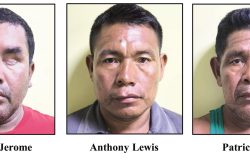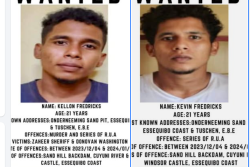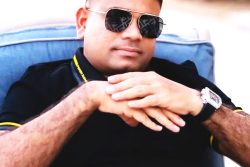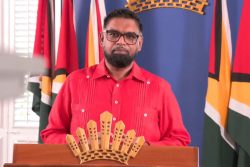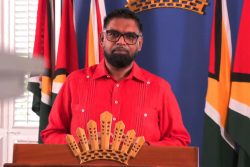 With over 30 albums and a range of songs, the energetic Guyanese-born chutney artiste, Terry Gajraj continues to tour and produce, more than two decades after his biggest hit. Earlier this year, he released online, “Awo Meere Pyaari,” a classic chutney soca melody that croons in English and Hindi, “Come to me my love.”
With over 30 albums and a range of songs, the energetic Guyanese-born chutney artiste, Terry Gajraj continues to tour and produce, more than two decades after his biggest hit. Earlier this year, he released online, “Awo Meere Pyaari,” a classic chutney soca melody that croons in English and Hindi, “Come to me my love.”
Yet, he is forever identified as the “Guyana Baboo,” having enthusiastically reworked old lines into the nostalgic namesake composition during an astonishing creative outpouring with friends, one night in a tiny Bronx, New York apartment in 1992.
As a homesick national, far from the fertile Fyrish fields and modest mandirs of his buoyant Berbice boyhood, Gajraj admitted that he initially found life, hard and lonely. “I had so many verses for that song, because I missed Guyana so much,” he would stress in interviews, “and wanted to go back…”
“Oh Bangali Baboo, Oh Bangali Baboo” he sang, seeking to assert his background and a distinct identity outside of the alienation, ambivalence and anonymity of a crammed North American city, “Me come from de country dey call Guyana, land of de bauxite, de rice and sugar.” This fitful yearning for home and the nagging desire for the familiar that bind and haunt so many migrants caught between worlds, are captured in the lyrics, crafted in the comforting raw daily dialect of Gajraj’s rural birthplace.
The piece’s deliberate vernacular insisted, “Me say pack up me grip (suitcase) and leh me go, Me gat fe go back ah Guyana some more” and his wry claim in the chorus “I am de very best ah de Guyanese Baboo,” contrasting with the repeated lament that is an acknowledgment of the diaspora’s shared immigrant history twice over.
I thought of Gajraj’s story and the shared echoes of the past, learning from my new-found great uncle, Windsor Professor Jang Singh about the Bengali origins of his and my mother’s grandfather, Redai Lall, whose father had migrated from the Bengal Presidency with two siblings, to British Guiana, passing through the bustling Calcutta, now Kolkata port along the ghats of the sprawling Hoogly River. The Lalls would end up staying in the colony saving their earnings and investing in large landholdings from former plantations on both banks of another waterway, the Mahaica River.
According to family lore, the lands owned by the oldest of the brothers became the village, Big Biaboo, the latter word, a translation of the fond reference Babu or Baboo, while the younger brother’s property, was termed Little Biaboo. Some descendants continue to live in the settlements, farming and keeping livestock like their ancestors.
A Facebook friend shared a recent Stabroek News column I wrote on the winding waterway to my grandparent’s farm at Regentback, likely a reference to Regentboch/ Regentboek, pronounced “Ritchieback” by my family, and now mangled into the barely recognisable “Region Back.” Uncle Jang, who migrated North in the 1970s, happened to see the article and commented publicly that we were related, leading to us finally linking up across the miles and years.
Redai and his wife Gangajali would present each of their nine children, including their daughters Kowsilla, Ramdai (Katie) and Hannah equal tracts. Their sons Nandlall, Ramlall, Lakhraj, Ramkumar (Tathi), Samlall and my grandfather Deolall also received acreage along the river.
Gangajali was named for the precious, hand-hammered pure metal container, normally of solid silver, that kept water from the sacred Ganges river for Hindu purification purposes. Traditionally, religious strictures prevented the faithful from crossing the sea or the dreaded kala-pani (‘black water’) and to do so could incur losing caste, risk expulsion and endanger social and financial standing.
Eventually, a pragmatic recommendation was made by royal advisers that offending ocean travellers carry Ganges water for daily use. Gangajali’s parents may have tried to preserve what they could of that special water carried aboard the sailing ship, or they may have seen in her a living legacy of their own beliefs and customs, and a human vessel for their lineage to last along the inscrutably black waters of a small river.
Now, I am amused to recall that as a student, I posed next to two such enormous silver urns on display in the famous desert city palace museum of Jaipur, Rajasthan without knowing my female ancestor’s symbolic name. The Pink City’s wealthy Maharaja Sawai Madho Singh II who ruled from 1880-1922 attended Edward VII’s coronation in 1901 and carried with him four of the vessels filled with around 9,000 litres of Ganga jal.
The Jaipur jars were made by silversmiths who melted 14,000 coins issued by the treasury. Ingots were beaten into smooth sheets of silver, and shaped over a wooden mould, taking two years to be completed. The urns, to store water from the Ganges, were intended for private ritual use at the Palace.
The title Babu or Baboo, is usually used in the Indian subcontinent as a sign of respect towards men, and even as a term of endearment by parents. In some areas, the honorific “ji” is sometimes added as a suffix to create “Babuji” for fathers and elders regarded as such. But in Bengal and other parts, it can also be applied broadly and affectionately, meaning baby or child, as well as younger brothers, sons or grands.
Referring to a native clerk during British-ruled India, it became a loose equivalent of “mister” or “sir.” Since the early 20th century, the term is employed by the media, to disdainfully refer to Indian public and government officials. So, there is “Babudom,” the “rule of babus” and common complaints, that even Guyanese can acknowledge, of far too highly paid “babus.”
British Captain William Angel who manned “coolie ships” like the “Sheila” that ferried indentured immigrants to British Guiana and the Caribbean, would cite a satirical song, “The Bengalee Baboo” in his memoir, “Angelmaster” first published a century ago. The “Baboo,” Ram Jam Tundah Ghose kept an early “e-shop,” long before Amazon, in Radha Bazaar where he sold everything from pens, paper, hairpins and pocket-knives, to macassar oil, Cashmere shawls, a second-hand portmanteau, Guava jelly, and Assam tea. He promised that, “Bye and bye” he would “make very long journey, Cross Kalla-panee I shall go…”
ID looks at her recent DNA test showing West Bengalese ancestry and thinks of the Lal brothers’ long voyage to Biaboo and becoming “Bangali Baboos.”
